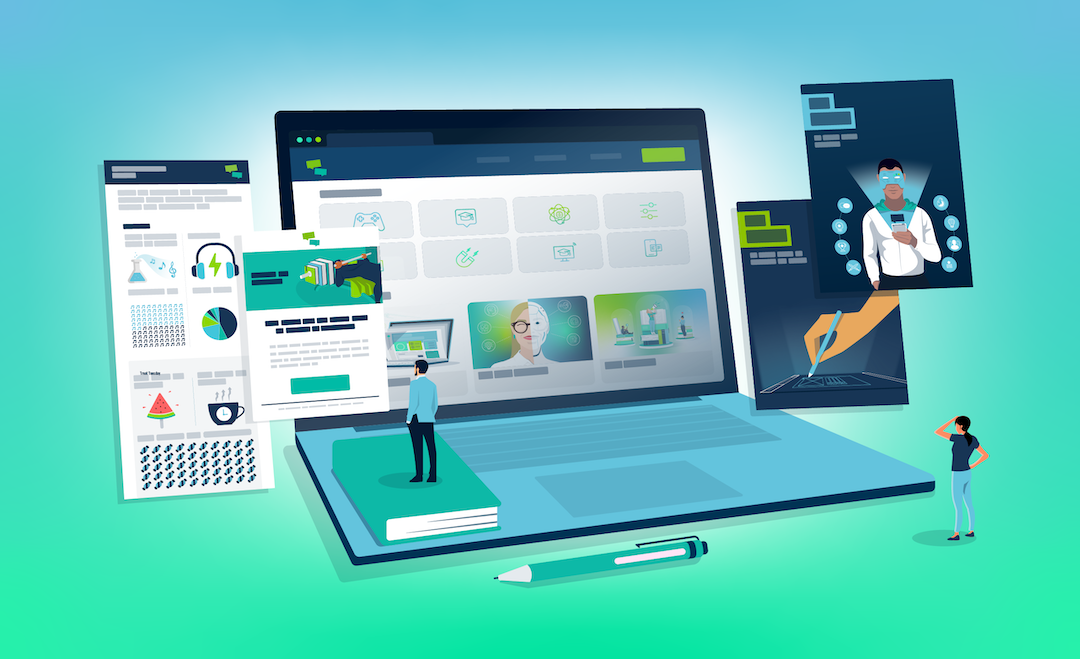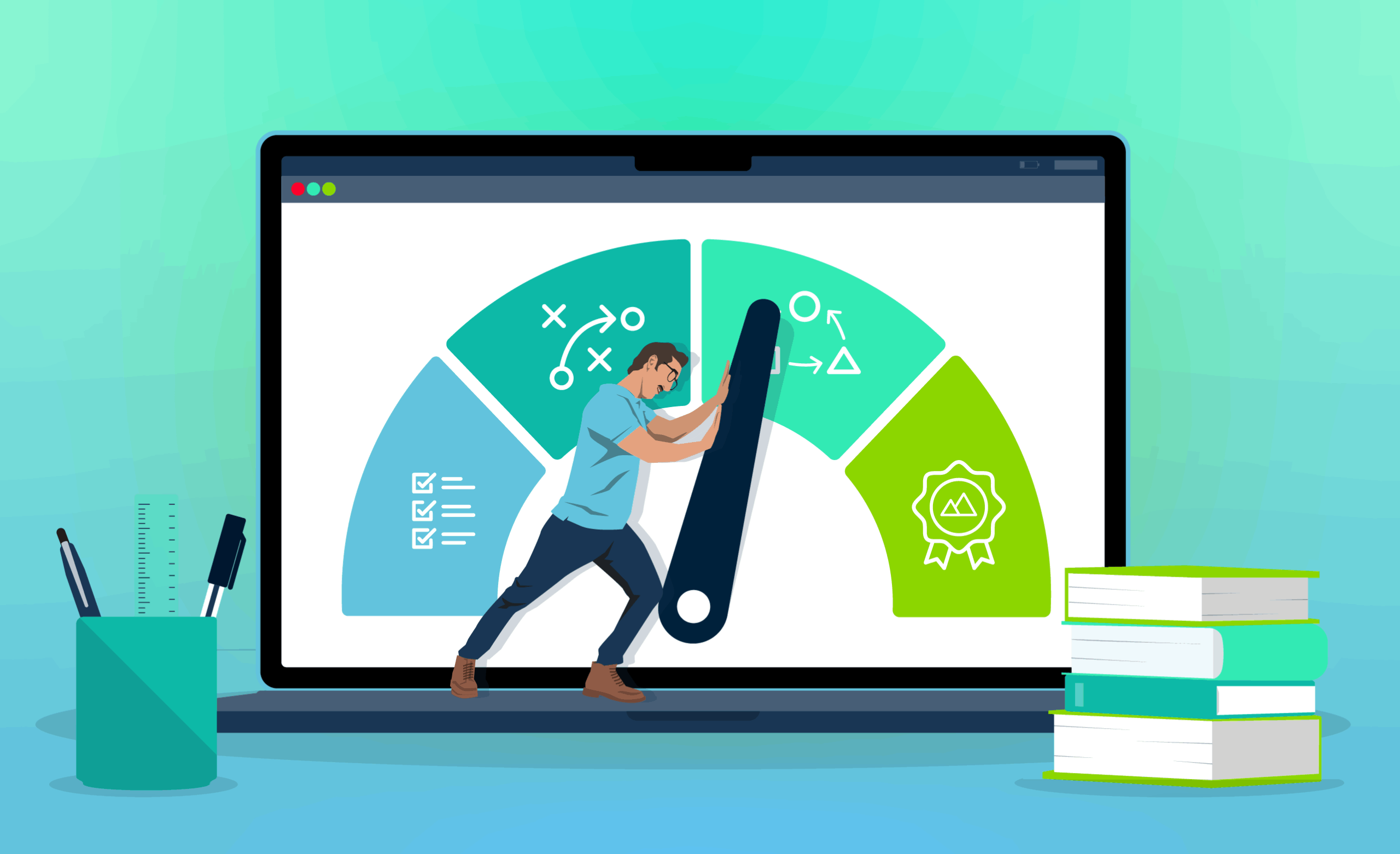
Agile learning has become a hot topic in the world of learning and development. After all, changes to the world and the way we work have kept us all on our toes.
Technology has transformed the way we communicate, the way we shop, and even the way we look for love. Society is changing faster than ever before and we need to respond ever more quickly to these changes.
But what has enabled us to be so adaptable? Agility.
The same is true in the world of business. According to McKinsey the pandemic accelerated digital transformation across business operations by ‘three to four years’. As the ATD notes, ‘the notion of business as usual has become a thing of the past’.
Combatting this change requires a flexible, agile approach. Indeed, a staggering 98% of companies have benefited from adopting an agile approach.
You need to implement agility in all areas of an organisation and L&D departments are no exception. Agile learning has become incredibly important. It compels us to not only create content quickly, but also consume content quickly.
But what exactly is agile learning? Furthermore, how can you cultivate an agile learning culture? In this article, we’ll tell you exactly how and more! Let’s get started and quick!
History of Agile Learning
Firstly, let’s take a look at how agile learning came into the picture. Before the technological revolution at the start of the century, L&D stuck to a rigid structure of training development. This could be likened to the waterfall model used by many software development teams.
This consisted of the following five stages:
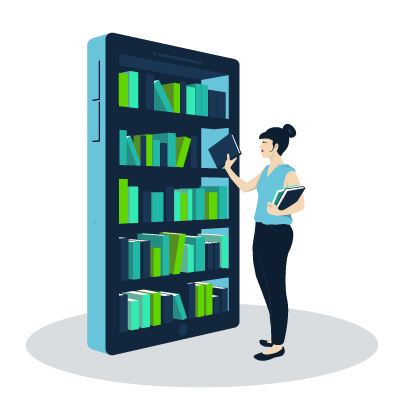
- Requirements: Determining your users’ needs and desires and documenting them as necessary.
- Design: Next up, you’d use your training needs analysis to build a blueprint for your training programme. You’d determine what to include, what it would look like and how long it would take to produce.
- Implementation: Once the planning is complete, it’s time to start building. At this stage, you’d create any training content necessary and share it with your learners.
- Verification: Once released, you’d need to check that your content is meeting your learners’ needs. You can achieve this through user acceptance tests and feedback forms.
- Maintenance: After all that hard work, you’ll need to check in regularly to deal with any issues that arise through user feedback.
You had to finalise and approve each stage of the waterfall model before moving onto the next. Therefore, any changes meant the whole process had to start from scratch.
Many development teams (and L&D departments) soon came to see this as a waste of time and resources. Did you know that inefficient processes can cost a company between 20 and 30% of their revenue each year?
As a result, there was a shift in mindset. Enter agile learning, stage left.
The agile framework comes from the world of tech. It’s all about approaching things iteratively and making sure that feedback is nonstop. This philosophy has now outgrown the tech world and is applied to all sorts of different industries.
Let’s take a further look at what agile learning is all about!
What is Agile Learning?
In a nutshell, agile learning means taking a continuous approach to learning. As we’ve seen, the term evolved from the software development industry. This is because electronic content development (or ‘eLearning’) has characteristics that are pretty similar to software development.
Agile learning focuses on speed, flexibility and collaboration. It works by transferring effective project management processes to the world of learning.
In particular, it has co-opted the Scrum framework. This approach breaks complex projects into smaller steps. As a result, work is separated into time-boxed interactions called sprints.
Therefore, agile learning moves in small steps and via an iterative process. That means continuously testing, refining and improving content until you’re pleased with the final result.
This led to the creation of agile learning design (ADL). Instructional designers and content creators use this approach to prioritise speed and flexibility.
Agile Learning Design
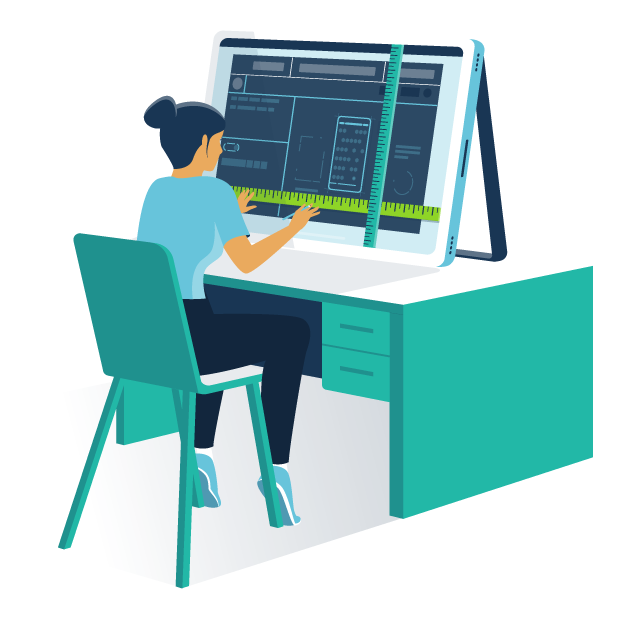
Agile learning design is one of many instructional design methodologies. Its main competitor is ADDIE which is an acronym for analyse, design, develop, implement, and evaluate.
As you can see from the name, there are quite a few steps within the ADDIE approach. Consequently, the speed of the process can be quite slow. Agile approaches were created to combat this.
For example, Rapid Content Development (RCD) has an interactive and iterative process. It also tends to prioritise speed of development above all other considerations.
Similarly, Rapid Application Development (RAD) uses different design methods to increase development speed and minimise the need for advanced planning.
Agile learning approaches are also known for their iterative nature. Content is created, updated, repurposed and reused wherever possible.
It takes around 180 hours (or just over one week) to create a single hour of regular eLearning. Naturally, if some of this content can be used again for future consumption, instructional designers will do so to save time.
To speed things up, subject matter experts (SMEs) are often of help. They help you save time, as you won’t need to conduct quite so much research. You’ll also be able to ensure that your content aligns with the needs of your workforce.
Having an agile culture in place is often a precursor to rolling out an agile learning approach. After all, your organisation’s learning function should be a reflection of your organisation’s vision and values.
Why An Agile Learning Culture is Essential
L&D professionals need to cultivate an agile learning culture and provide learners with the right tools for agile learning. Unfortunately, a standard LMS might not cut the mustard.
In an agile learning culture L&D isn’t an island. Instead, L&D professionals are always in dialogue with frontline workers and internal experts.
In this way, L&D becomes a two-way street. Employees keep the L&D team clued in on industry changes. Then, L&D quickly provides the support and training required for the business to keep in line.
Corporate agility is like practising mobility exercises. Without it, we may become inflexible and stagnant. A few particular advantages include:
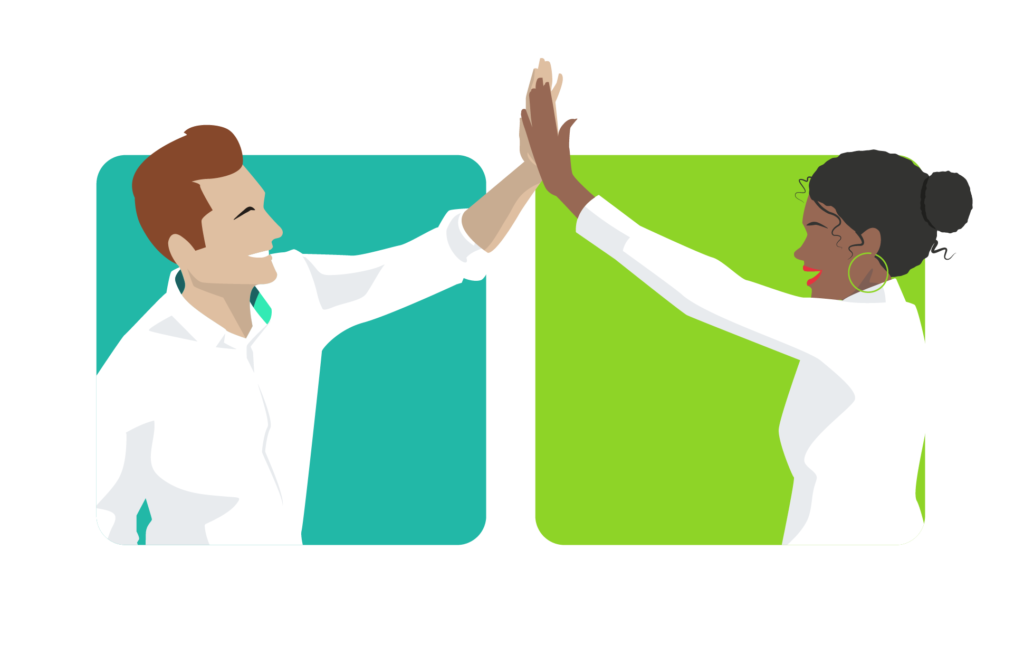
Improved visibility: 76% of users choose agile planning tools to increase the visibility of their projects. Better visibility means enhanced information sharing, better communication and more informed decision making.
Improved efficiency: In a recent report, Forbes interviewed over 500 senior executives about business agility. A whopping 92% agreed that using an agile framework is crucial for their company’s success.
Improved collaboration: Increased collaboration has benefits all round. Research shows that better collaboration in the workplace improves business processes. This reduces time from idea conception to when it’s available for sale by 20% and increases successful innovation by 15%.
But how do you build an agile learning culture and get to reap these benefits? We’ll tell you exactly how!
Five Top Tips for Building an Agile Learning Culture
1. Make Communication a Two-Way Street
Communication is the key to creating trust among colleagues. If you want to keep agile, then take notice of your ears on the ground — your workforce. When you listen to your colleagues and take them seriously, they’ll naturally feel more appreciated. Businesses with happy workers are likely to outperform competitors by 20%.
There are tons of ways you can create a hub for communication between colleagues. On Growth Engineering LMS, you can make use of social learning features that facilitate easy communication between anyone and everyone.
Take Live Chat, for example. Workers can cut down on time spent having to wait for colleagues to respond to emails and can get a response to their messages in seconds. A survey found that effective communication can save companies $64.2 million a year on average.
Here’s our very own Ideologist in Chief, Juliette Denny, discussing the importance of communication and creating a knowledge sharing culture:
2. Make Learning Continuous
“I have no special talent, I am only passionately curious,” said Albert Einstein, one of the most intelligent minds the world has seen. Businesses can use Albert’s words of wisdom as a source of inspiration.
As soon as a company stops striving for brilliance through learning new things, they become constrained and stagnant. It’s imperative that you keep up with the market and innovate wherever you can.
Instead of turning a blind eye to that hot new competitor, study them, learn from them and overtake them! Similarly, you need to make sure to always update your learning content and that your learners are aware of market changes.
This can be demonstrated by how one of our Fortune 500 clients used Growth Engineering Authoring Tool to create content which helped employees adapt to a post-Covid world. Their ‘Back to Store’ safety guidelines generated excellent completion rates (81%) across all units!
3. Make Training Micro!
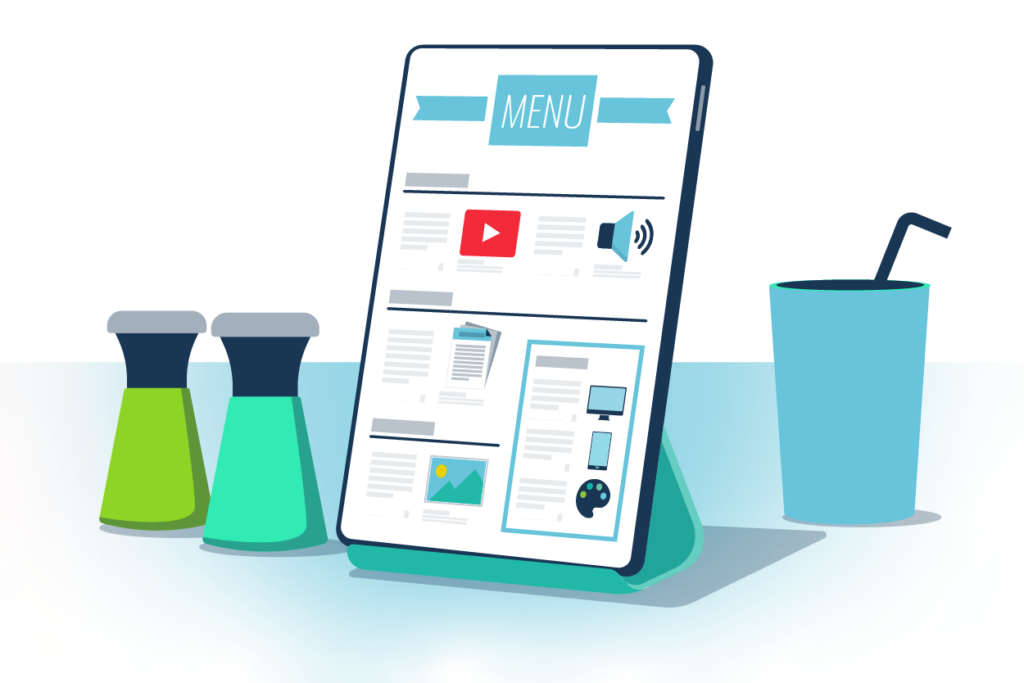
Microlearning is learning that happens in short bursts. It repackages longer form content into smaller chunks that are designed to be completed in a short amount of time.
Because of our rapidly shrinking attention spans (eight seconds!), microlearning works incredibly well for the modern learner and can increase engagement by 50%.
Microlearning content is also focused into short and achievable goals. As such, microlearning is the perfect vehicle to fuel agile learning approaches.
Micro-units can be produced quickly, freeing up content creators to concentrate on other projects. In fact, microlearning can cut development costs by 50% and increase the speed of development by 300%.
4. Involve Subject Matter Experts
One of the main signs of an agile company is the championing of collaboration and sharing. This is where your subject matter experts come in.
A subject matter expert is someone who reigns over a certain topic and is a fountain of knowledge for your learners to drink from. Your colleagues will often have untapped potential which you can utilise. A social knowledge sharing tool will help your learners share and track that information.
On Growth Engineering LMS, for example, learners have access to an Experts Area where they can find the right SME and ask them a question. Everyone at the company can also view the answers. This creates a library of information and preserves your intellectual capital.
Additionally, Admins can collaborate with subject matter experts to create actual learning content. If they find learners frequently ask the same questions, you can create modules on the topic.
5. Go Mobile!

Mobile learning allows learners to learn anytime and anywhere. This fits perfectly into the agile learning framework.
If there are any sudden updates or occasions where the learner needs to learn something quickly, then mobiles are always there. People now check their mobiles about once every ten minutes. This makes them the perfect device to deliver training content on.
Growth Engineering Learning App is an engaging learning environment condensed into a mobile learning app. This inspires agile learning as mobiles are great for learning on-the-go. No longer do we have to wait weeks for updates. You can now download and consume them on the commute to work!
Growth Engineering Learning App also promotes agile learning by encouraging a knowledge sharing culture. Learners can post updates to social streams just like they can on other social networks.
This way, they’re able to learn from each other and discuss topics in detail. Studies show that learners who discuss content they’ve learned tend to test better than those who don’t.
Final Words
Just like having an agile business, agile learning comes with a variety of benefits. It allows learners to remain up to date with current market knowledge, breaks learning down into more digestible chunks and enables increased collaboration.
However, it must be said that agile learning won’t be a great fit for all your learners. Some prefer a slower and more structured pace that allows them to fully get to grips with things before moving on.
It’s important to consider them if you’re contemplating moving to an agile learning format. For the rest of us, it’s full speed ahead!
At Growth Engineering, we’re dedicated to adapting quickly to market changes and ensuring our solutions reflect that. Get in touch with us today to learn more about our brand new Impact Suite!



